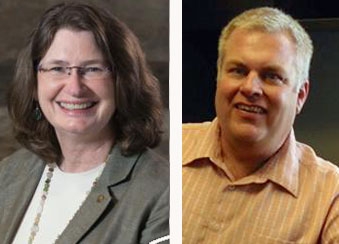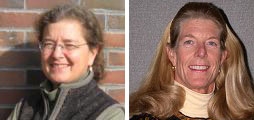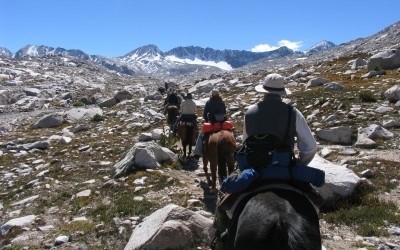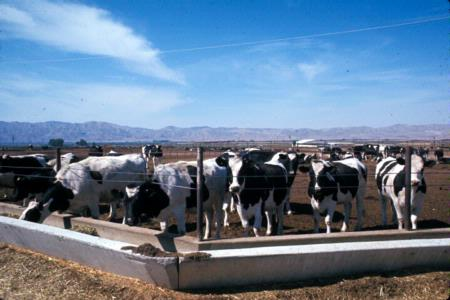
Posts Tagged: Jim Sullins
Three long-time UC ANR academics in Tulare County retire in 2015

Retiring this year will be:
Jim Sullins, director of UC ANR Cooperative Extension in Tulare and Kings counties and livestock range, and natural resources advisor, retires after 32 years of service. Sullins began his UC ANR career in Southern California, serving as livestock and range advisor for San Bernardino, Riverside, Los Angeles and Orange counties.
Early in his career, Sullins' work in rangeland management focused on applying scientific principles to the relationship of livestock grazing and implementation of the Endangered Species Act.
In July 1993, Sullins took the position of UC ANR CE director and livestock, range and natural resources advisor in Tulare County. In the advisor aspect of this role, he concentrated on watershed management and control of invasive species.
“I am proud to say we have been responsible for the untimely demise of many yellow starthistle plants,” Sullins said.
A significant moment in his career was prompted by the devastating citrus freeze of 1998. UC ANR CE stepped forward – as it did following after the previous “100-year freeze” of 1990 – to aid the community after thousands of acres of citrus were damaged and thousands of workers lost their jobs. Sullins co-chaired the community Freeze Relief Committee and the Fund Raising Committee, working with numerous nonprofits and establishing partnerships that have endured for years, enabling collaboration on additional projects.
Another major event during Sullins' tenure was development in 2001 of a new agricultural complex for UC ANR Cooperative Extension and the Tulare County Department of Agriculture. Sullins worked with the Tulare County Board of Supervisors, the Tulare County Agricultural Commissioner and industry support groups to build a modern and highly visible facility across Laspina Street from the World Ag Expo grounds in Tulare County.
Three years ago, Sullins also took the reins of UC ANR Cooperative Extension in Kings County.
“I believe that Cooperative Extension is the very best organization of its kind on earth,” Sullins said. “I have worked with committed and highly trained professionals who make a difference in the lives and livelihoods of the people they serve.”
In retirement, Sullins said he and his wife will ride California's highways and byways on his Harley motorcycle – a hobby he recently revived after a 30-year hiatus. He also plans to write some opinion pieces and look into editing and publishing two books written by his late mother. Retirement will also give him more time to spend with his grandchildren and following baseball. Sullins will stay active in the community as a volunteer with the World Ag Expo, working with the Happy Trails Therapeutic Riding Academy, and as president of the County Center Rotary Club in Visalia.
Cathi Lamp – nutrition, family and consumer sciences advisor – is completing a 27-year career with UC ANR Cooperative Extension. Lamp joined the organization after working for 10 years in the Tulare County Department of Health as a public health nutritionist.
She said the position appealed to her because it involved both research and community nutrition. Her work on a “nutrition plate” project exemplified the ability she had to identify a need in the community, find a solution, research its effectiveness and see the results benefit society.
“Years ago, the educators I worked with were telling me that people didn't understand the abstract nature of nutrition guidance in pyramid form,” Lamp said. “We started using a plate as a nutrition education tool in Tulare County.”
This led to a statewide research project to evaluate the use of the plate showing the proportions of foods needed to achieve a healthy diet in nutrition education. Lamp and her colleagues took the project a step further and photographed plates of familiar foods in proper proportions to demonstrate the concept. The pictures were evaluated by low-income families and many changes were made based on their feedback. The photographs are now incorporated into posters, handouts, and other teaching aids and are used in conjunction with nearly all UC ANR nutrition curricula for youth and adults. A UC ANR nutrition specialist asked if she could share the work conducted in California with USDA.
“She thinks that our project was instrumental in the eventual adoption of MyPlate to replace MyPyramid by USDA,” Lamp said. “We saw a local need, worked on it, did a study and developed it further, and had a considerable impact on providing clear nutrition education.”
In retirement, Lamp plans on traveling extensively, with places in Europe, Asia and Australia on her list of international destinations, plus sites in the U.S., including Savannah, Charleston, Austin and many national parks. She is interested in training from the Society for California Archaeology that will allow her to visit and record changes at archaeological and historical sites in the state.
Neil O'Connell, UC ANR Cooperative Extension citrus advisor, retired after 34 years serving Tulare County citrus producers. O'Connell studied entomology in college and took a position with Sunkist Growers, Inc. and then a packing association affiliated with Sunkist in Visalia. When he learned the local citrus advisor, John Pierson, was moving to a specialist position at the UC ANR Lindcove Research and Extension Center, he applied for the extension job.
O'Connell developed a strong relationship with citrus farmers and pest control advisers working in the citrus industry.
“They trusted my judgement and experience,” O'Connell said. “My interaction with growers was always pleasant and they were very appreciative of my efforts to help them solve problems.”
He views the current battle to control Asian citrus psyllid and the pest's ability to spread huanglongbing, a devastating citrus disease not yet found in California, as the biggest challenge to citrus producers since he became involved with the citrus industry four decades ago.
“Asian citrus psyllid and huanglongbing have stimulated a tremendous amount of research work in Florida and at the University of California,” O'Connell said, adding that he believes in the resiliency of California growers to overcome the challenge with the help of world-class University of California researchers.
O'Connell and his wife wish to travel in retirement, including trips to Alaska and Pacific Northwest among the first.
UC ANR rebuilds its academic staff

Barbara Allen-Diaz, vice president of UC Agriculture and Natural Resources, noted in the story that 2013 was the first time in recent years that UC hired more Cooperative Extension faculty than had retired. In December, she approved hiring of another 29 advisors and 16 specialists for the 2015-16 cycle.
"So we turned the corner for the first time in this long downward spiral," she said. "My goal is to continue to rebuild the footprint of Cooperative Extension."
Lee also interviewed UCCE vice provost Chris Greer, who said he expects ANR to end 2015 with a net gain of academics.
"It's not huge leaps and bounds; it's a small gain, but we're hoping as we continue this process of filling these positions, that we'll start gaining some ground," he said.
Rather than automatically refilling vacant positions, Greer said much thought is put into revamping job descriptions or creating new positions to better fit the evolving needs of agricultural business. To help prioritize which positions should be hired first, UC sought public input, receiving more than 900 individual comments last year, including from agricultural organizations.
Jim Sullins, the UCCE director for Tulare County who is planning to retire in mid-2015, said more advisors are covering multiple counties and must travel longer distances to make farm visits, so they are turning to new communications strategies in their work, such as email, social media, and other web technology. But traditional farm calls are still a mainstay service.
Katherine Pope, the new UC Cooperative Extension orchard systems advisor in Yolo County, was also featured in the AgAlert story. She talked about the importance of having enough staff to enable advisors to call on farmers personally. Pope said going out to the farm gives her a fuller picture of what she's dealing with that she can't get over the phone or with photos via email. Sometimes she may notice other issues unrelated to the original problem, or the visit may prompt other questions from the farmer.
"My job is to spread information and knowledge, and doing that in person is absolutely the best way to do that," she said.
New advisors build on the scientific work of predecessors

Sullins was quoted in an article by Luiz Hernandez in the Visalia Time-Delta that focused on the retirements of two long-time Tulare County farm advisors, Michelle Le Strange and Carol Frate, who together represent nearly 70 years of service to farmers, landscape professionals and the public.
"Both Carol and Michelle have been very dedicated advisors, committed to their clientele, and driven to help resolve grower's problems, and helping the general public make informed decisions, based on science," Sullins said. "It will take a lot of adjustment with them not on staff.
Hernandez contacted Frate by phone from vacation in Olympia, Wash. A 36-year UCCE veteran, she commented on a research trial conducted in the 1980s in which she sought to determine how much damage an alfalfa crop sustained if irrigation stopped in the summertime.
"It has come in handy in drought" Frate said. "We showed alfalfa could withstand, survive" a water stoppage.
Le Strange, who completed 31 years with UCCE, said she became interested in food production following a trip to Mexico and Guatemala. She went to college at UC Davis and accepted her position in the San Joaquin Valley.
"We are here to help find solutions for local agriculture problems," she said. "I am proud of all the research I have done."
Tulare County supervisors support commercial pack animals in national parks
The Tulare County Board of Supervisors voted to support a bill introduced by Congressman Devin Nunes, R-Tulare, allowing businesses that rent pack mules and horses to operate in Sequoia and Kings Canyon national parks while a new wilderness plan is implemented, according to the Visalia Times-Delta.
In 2009 a High Sierra Hikers Association sued the National Park Service for failing to conduct an adequate environmental impact analysis of its wilderness plan. As a result of the suit, a judge ruled that the service no longer has the authority to issue permits to the companies that rent pack animals.
Before the supervisors' vote, Jim Sullins, director of UC Cooperation Extension in Tulare and Kings counties, said years of research done by UC Davis and UC Cooperative Extension wasn't included in the U.S. Park Service's response to the lawsuit.

National Park Service photo.
Media seek comment from UC experts about cow disease
The case of bovine spongiform encephalopathy discovered in Fresno County is an atypcial varient that happens in cattle similar to sporadic Cruetzfeldt-Jakob, accoring to a report in the Fresno Bee.
Jim Sullins, University of California Cooperative Extension advisor and county director in Tulare and Kings counties, told the Bee classical mad cow disease such as the kind found in England in the 1990s causes cattle to stagger and act erratically. By contrast, cattle affected with the atypical form show no outward signs of being affected but their brain tissues shows deterioration, he said.
The Fresno Bee said the dairy cow was slated to be rendered at a Fresno County plant. Other media reports said the rendering plant is in Hanford. The cow originated at a dairy in Central California.
A story on Fox 40 said the discovery is likely to erode consumer confidence in beef, even though the form detected is technically of no threat to humans.
"It's a three-dimensional protein and it folds and in certain configurations it causes problems in the brain and nervous tissue," said UC Davis veterinary professor and food supply expert Jim Cullor.
Christina Sigurdson, assistant professor of pathology at the University of California at San Diego, said atypical mad cow disease usually occurs in older cattle. The origin is not known. Scientists speculate that atypical mad cow disease happens in cattle similar to sporadic Creutzfeldt-Jakob disease in people -- a degenerative brain disorder thought to arise without any exposure to prions, or abnormal proteins.
Other UC comments were on:
- Fox News Latino - Mad cow disease found in USDA test
- National Public Radio - Mad cow disease: What you need to know now
- Visalia Times-Delta - Infected cow came from a Tulare County dairy

dairy cattle
